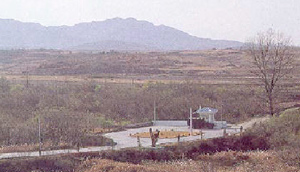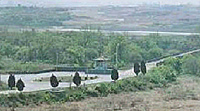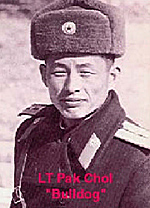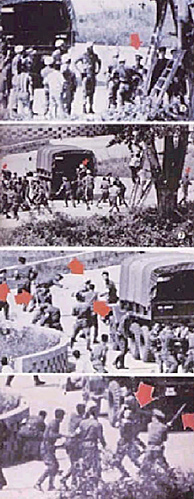 In 1953 the Korean War ended. The North Korean People’s Army (NKPA) and the United States, signed a shaky armistice that has endured through fifty years of incursions and breaches. Although there has been fifty years of contact with the NKPA, very little is known about them, although there are a few books on their military strengths.
In 1953 the Korean War ended. The North Korean People’s Army (NKPA) and the United States, signed a shaky armistice that has endured through fifty years of incursions and breaches. Although there has been fifty years of contact with the NKPA, very little is known about them, although there are a few books on their military strengths.
Joint Security Area: With poplar tree.
North Koreans, from a young age are taught to hate Americans and their allies. Above the 38th parallel, where the Demilitarized Zone (DMZ) divides the two countries, the North Koreans have looked south with great interest, observing the Republic of Korea (ROK) and US movements, training and activities. In 1972 the premier of North Korea, Kim Il Sung, announced “the tense situation forces us to continue to step up preparations for war. We make no secret of this. Who can guess when the US imperialists will attack our country again? The most important thing in our war preparations is to teach all of our people to hate the US Imperialism."
From childhood the people of North Korea have been brainwashed into hating all Americans. It filters into every facet of North Korean life, from military training to the classroom. In America very little is said about the North Koreans, unless some incident occurs. The world media’s attention was fixed on North Korea after it captured the USS Pueblo, and released the soldiers of the craft nearly a year later in the winter of 1968; the attack on the Army Support Group Advance Camp in August of 1967, which killed one US and two ROK soldiers; the ambush of a United Nations Command (UNC) convoy bringing relief to the guards at Panmunjom, resulting in four deaths in April of 1968; and the murders of Captain Arthur G. Bonifas.and 1st Lieutenant Mark T. Barret. These are only a small portion of the nearly two thousand violations that the North Koreans have commited in the past fifty years.
 Joint Security Area: Without poplar tree.
Joint Security Area: Without poplar tree.
Panmunjom is a small village that is actually north of the Joint Security Area (JSA). The US soldiers who work there also call it ‘propaganda village’. The North Koreans People Army shows off its best troops at Panmunjom and in the Joint Security Area. In fact North Korea really has no other place to demonstrate to the world how much more superior it is to the United States. The North Koreans have taken every opportunity created by the high visibility to build their model Korean village, and to show the world that they are better than South Korea. It is a case of one-upmanship.
On the south side of the DMZ, the UNC officers and men have to meet strict requirements to be selected to go to the JSA. And there is no doubt that the North Koreans have the same requirements, sending only their best soldiers.
 One of these soldiers was Senior Lieutenant Pak Chol, the North Korean equivalent of a staff sergeant, at Panmunjom during the 1970s. He received his commission when, in a scuffle with a UNC soldier, he kicked him in the groin. One of his American counterparts remembers Pak as a soft-spoken leader who was zealously patriotic. While stationed at the DMZ,. Pak earned the nick-name ‘Bulldog’ because of his stolid face, with no sign of emotions, and because if there was a incident at the DMZ, he was probably in the middle of it.
One of these soldiers was Senior Lieutenant Pak Chol, the North Korean equivalent of a staff sergeant, at Panmunjom during the 1970s. He received his commission when, in a scuffle with a UNC soldier, he kicked him in the groin. One of his American counterparts remembers Pak as a soft-spoken leader who was zealously patriotic. While stationed at the DMZ,. Pak earned the nick-name ‘Bulldog’ because of his stolid face, with no sign of emotions, and because if there was a incident at the DMZ, he was probably in the middle of it.
Joint Security Area Map (slow: 115K)
“Mi Kun Chu I Cha”
In 1976, in the JSA, between Checkpoint Three and Five there was a poplar tree that stands in the direct line of sight of the two posts. Checkpoint Three is often called the loneliest place in the world, because all it could see in the summer was North Korean checkpoints and because the poplar’s big branches blocked the view of Checkpoint Five.
In early August 1976 it was decided that the poplar tree had to be trimmed, like it had been every year prior. When the UNC work detail went out the first time they had been told by the North Korean People’s Army that if they cut the tree, then the North Korean guards would kill them. Hearing this the UNC work detail returned to the JSA Advance Camp.
When the work crew returned to the Advance camp, Captain Arthur G. Bonifas and First Lieutenant Mark T. Barrett were selected to lead the return of the UNC work force on August 18. Bonifas was one of the happiest people in the DMZ since in two weeks he would be returning to his home in Newburgh, New York. In contrast, Barrett was still getting used to Korea, having been in country for only one month.
The work force arrived at Checkpoint 3 at 1040. and started the routine job in a peaceful atmosphere.. Three of the workers climbed into the tree and, using axes, started to trim back the branches. The remaining equipment, including two small handsaws, two bigger saws, a large hand axe, one machete, and a chainsaw, was left lying against the tree.. The two other members of the team, Mr. Kwak and Lee Hyong No, remained on the ground to remove the cut branches when they fell.
Approximately five minutes after the group started cutting the tree, Pak and ten other guards arrived at the location in a jeep and started to watch the work being done. Pak knew that his side had told the Americans to stop cutting the tree several days ago, and now here they were cutting at the tree again. Knowing that senior communist leaders would approve of any incident that would provoke a US response, Pak and his guards observed the American for ten to fifteen minutes. They were, to Pak and his men, “hooligans of the US imperialist aggressor's army” and little more than vandals.. Pak watched until he was absolutely sure that the work crew was going to cut away the tree that Premier Kim Il Sung had nurtured, then he made his move.
Pak approached Bonifas and told him to cease the work immediately. The UNC crew, he said, could not resume work again until an agreement was reached on the status of the tree at a security officer’s meeting. Bonifas responded by telling Kwak to continue working on the tree. This was a routine job and the UNC was going to complete it, no matter what threats the NKPA could shout. This attitude infuriated Pak, who was enraged that the UNC had the nerve to refuse his directive. Pak began yelling -- first at Bonifas and then, in Korean, at the work detail. His threats to kill the work team and the UNC guards if they continued to cut the tree left the three men up in the tree in a very precarious place.
 Bonifas just turned his back on Pak and told the workers to continue the job. Noticing that he was quickly losing control of the situation, Pak called for his ten other men and sent one to gather other guards. Once his reinforcements arrived, bringing the total number of North Korean guards to thirty, Pak slipped off his watch, wrapped it in a handkerchief and placed it into his pocket. Shouting “MI KUN CHU I CHA,” (“Kill the American Aggressors,”) he pounced on Bonifas, knocking him to the ground, whereupon he was beaten to death by at least five of the NKPA guards.
Bonifas just turned his back on Pak and told the workers to continue the job. Noticing that he was quickly losing control of the situation, Pak called for his ten other men and sent one to gather other guards. Once his reinforcements arrived, bringing the total number of North Korean guards to thirty, Pak slipped off his watch, wrapped it in a handkerchief and placed it into his pocket. Shouting “MI KUN CHU I CHA,” (“Kill the American Aggressors,”) he pounced on Bonifas, knocking him to the ground, whereupon he was beaten to death by at least five of the NKPA guards.
The Axe Murders: Red arrows indciate North Korean Officers and soldiers attacking US and UNC forces near the poplar tree.
According to the observers at check point five remember the next several minutes going by in a blur. At one point Lt. Barrett tried to break up the fight, but was chased away by three North Koreans wielding axes, and killed near the tree. The end of the fight was signaled by one US troop driving the 2-˝ ton truck over the fallen Bonifas, protecting him from further beatings. The NKPA soldiers retreated to their side of the line and almost immediately, the NKPA called for a security officer’s meeting between the two sides, to discuss the incident.
By this point the Medivac Helicopter from Camp Casey’s 121 Medical Hospital was already in flight with orders to pick up two dead and at least 9 wounded, including one ROK officer and eight enlisted soldiers from both the ROK and US Army.
North Korean Foreign Minister Ho Dan informed his nation’s press “that the Imperialistic US troops, with lethal weapons pounced on and attacked the North Korean guards, who went to peacefully protest the cutting of the tree; that the guards had to fight against the aggressors in self-defense and that the incident was a planned provocation by the US imperialist forces. War could break out at any moment."
The UNC, as it prepared to release its press statement, alerted the entire Second Infantry Division (2ID), waiting to see what North Korea would do, hoping that an all out war was not about to start.
Operation Paul Bunyan - The Korean Axe Murders: Retaliation
Operation Paul Bunyan: Eyewitness Account of the Deaths of Bonifas and Barrett
Back to Cry Havoc! #44 Table of Contents
Back to Cry Havoc! List of Issues
Back to MagWeb Master Magazine List
© Copyright 2003 by David W. Tschanz.
This article appears in MagWeb.com (Magazine Web) on the Internet World Wide Web. Other articles from military history and related magazines are available at http://www.magweb.com